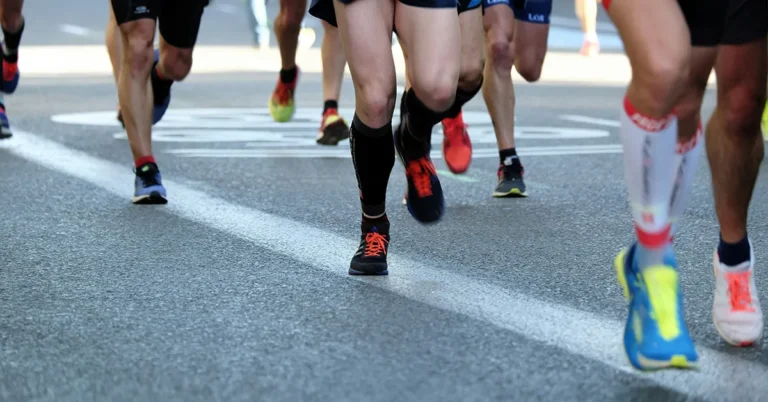Top 5 running injuries: How to treat them
The top 5 running injuries is a list of some of the most common conditions we see and hear our running customers complain of:
- Achilles tendon pain
- Iliotibial band syndrome (ITB)
- Shin splints
- Plantar fasciitis
- Runners knee (patellofemoral pain syndrome)
Achilles tendon pain in runners
Achilles tendon pain is common in the running and general population. The Achilles tendon is at the back of the heel and is the largest tendon in the body. It can work under huge loads and is most commonly caused by the following issues:
- Sudden increase in intensity/load (Too long or too quick a run, often associated with beginners, those returning from illness or injury or those not following a training plan)
- Inadequate strength training
- High body weight compared to leg strength
- Lack of ankle joint mobility
- Previous injury
Iliotibial band syndrome (ITB) in runners
Iliotibial band syndrome is caused by the compression of the ITB at the side of the knee. The band is a thick and taut piece of connective tissue (and cannot be stretched!) down the outside of the leg. It is involved in the control of hip and knee alignment during loading (especially on a single leg- hence runners can commonly get issues). What causes these issues:
- Sudden increase in intensity/load (Too long or too quick a run, often associated with beginners, those returning from illness or injury or those not following a training plan)
- Inadequate strength training at the hip (or generally in the leg) leading to poor hip/knee control
- Pelvis width to knee position during running (women can have a slightly wider pelvis for childbirth which makes them more likely to develop ITB pain)
- High body weight compared to leg strength
- Poor control of pronation in the foot (or as a result of ground conditions e.g. sand, mud or poor footwear)
Shin splints in runners
There are four different types of shin splints but the most common is medial shin pain. They are usually injuries to the soft tissues but can lead to stress fractures in some cases. There are a number of common influencing factors:
- Sudden increase in intensity of loading with insufficient time for the tissues to adapt
- Peak loads caused by hard surfaces or poor footwear
- High bodyweight compared to leg strength
- Foot issues – poor control of pronation in the foot (causing pulling of tissues) or high supinated foot position (adversely effecting load absorption properties of the foot). Hence, some runners may need orthotics to help control the foot and others shock absorbing insoles to cushion the foot.
- Lack of ankle joint mobility
Plantar fasciitis in runners
Plantar fasciitis is the term most commonly used for heel pain from the plantar fascia. The facsia is subject to a lot of loading in runners and can be caused by many of the same problems as both Achilles tendon pain and shin splints:
- Sudden increase in intensity of loading with insufficient time for the tissues to adapt
- High bodyweight compared to leg strength
- Foot issues – poor control of pronation in the foot (causing pulling of tissues) or high supinated foot position (adversely effecting load absorption properties of the foot). Hence some runners may need orthotics to help control the foot and others shock absorbing insoles to cushion the foot.
- Lack of ankle joint mobility especially tight calf muscles
Runners knee (patellofemoral pain syndrome) in runners
There are many names for this problem: runners knee, anterior knee pain, patellofemoral pain syndrome, chondramalacia patellae to name a few. The main causes are load and lack of strength both of which we see as common mistakes by runners. But there are other factors:
- Sudden increase in intensity of loading
- Lack of strength in lower limb especially at the knee and hip
- High bodyweight compared to leg strength
- Foot issues – poor control of pronation in the foot
- Lack of ankle joint mobility especially tight calf muscles
Top tips on how to treat running injuries:
- Most running injuries are caused by overuse (excessive intensity) so remember to follow a clear training plan and take into account the frequent changes that can occur. When you run don’t just listen to the heart and lungs and how they are coping, watch out for signs from the rest of the body. Don’t be fooled into thinking you need to run fast all the time. A good middle distance runner will perform 80% of their weekly volume running at a slow / easy / talking pace, with the other 20% being dedicated to speed work or hill runs, etc. depending on their requirements. This split has been linked with reduced injury incidence. https://www.runnersworld.com/uk/training/motivation/a27718661/what-is-80-20-running/
- Prepare more fully than just running. Warm up, cool down, eat well, hydrate sufficiently. Create a physical training plan to address flexibility or leg strength issues
- Top runners carry very little ‘dead’ weight. They are very lean machines! This is not achievable for most of us but we can control the balance between our body weight, leg strength and training intensity. If you are overweight then strengthen your legs and build intensity gradually.
- The most predictive factor for developing an injury is having had a previous injury. This is often because the injury has not been assessed or rehabilitated adequately. So if in doubt see a sports physiotherapist who will assess, diagnose and plan your rehabilitation.
If you are a runner and you are suffering from any of the above running injuries it might be time to see a Physis Physiotherapist. Online Bookings can be made HERE or call us on 0131 478 4646. Or email us at: [email protected]


